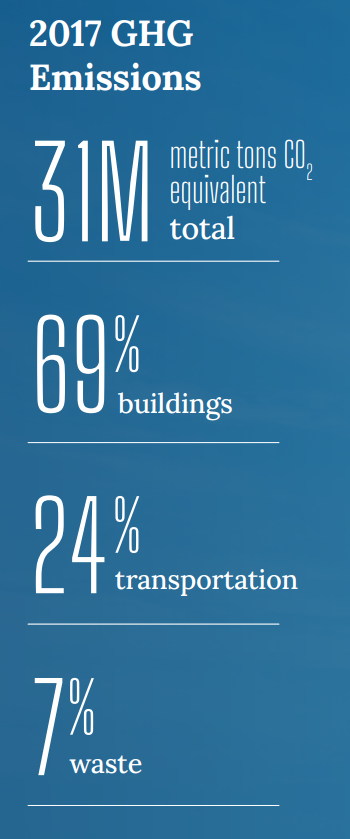Electrify Chicago
An independent tool for viewing City of Chicago building data
According to the
2022 Chicago Climate Action Plan,
69% of Chicago's emissions come from buildings, making
building emissions our biggest challenge and our biggest opportunity as a city
to tackle climate change. At Electrify Chicago, we showcase building performance using
publicly available data supplemented by community-submitted photographs and building
owners.
Start by looking at Chicago's buildings with the highest greenhouse gas intensity i.e. emissions per square foot. Large, efficient, buildings can perform much better than very inefficient small buildings on this metric.
New Article
📰 $30 Million In Missed Fines
The City Of Chicago failed to collect $30 million in potential fines from the building benchmarking ordinance, reducing transparency and accountability.
Legislative update! 🎉
As of late January 2024, legislation is being introduced to require new use more efficient forms of water and space heating, via the Clean And Affordable Buildings Ordinance (CABO), which will reduce the number of highly polluting and inefficient buildings that end up on this site.
If you're in Chicago,
write to your alderman to support the CABO!
Chicago Buildings by Greenhouse Gas Intensity
Note: Data includes large Chicago buildings with data from 2022, unless explicitly stated otherwise.
Note: This data only includes buildings whose emissions are reported
under the
Chicago Energy Benchmarking Ordinance. According to the City “As of 2016,
this list includes all commercial, institutional, and residential buildings larger than
50,000 square feet.” This dataset is also then filtered to only buildings with
reported emissions > 1,000 metric tons CO2 equivalent.
The latest year of data is from 2022, but we update the site regularly when new data is available, and some buildings may have failed to report that year, and only have older data available.
| Property Name / address | Primary Property Type |
Greenhouse Gas Intensity (kg CO2 eq./sqft) |
Total Greenhouse Emissions (metric tons CO2 eq.) |
|---|---|---|---|
|
332 Property LLC
332 S Michigan Ave
| Office | 6.6 kg/sqft
Highest 47%
| 3,509 tons
Highest 11%
|
|
300 South Wacker Property LLC
300 S Wacker Dr
| Office | 6.6 kg/sqft
Highest 47%
| 4,014 tons
Highest 9%
|
|
230 W Monroe
230 W Monroe
| Office | 6.6 kg/sqft
Highest 47%
| 4,459 tons
Highest 8%
|
|
Leo Burnett Building
🚩
35 W Wacker Dr
| Office | 6.6 kg/sqft
Highest 47%
| 9,237 tons
Highest 3%
|
|
311 S Wacker
🚩
311 S Wacker
| Office | 6.6 kg/sqft
Highest 47%
| 9,513 tons
Highest 3%
|
|
901 905 W ARGYLE ST
901 905 W ARGYLE ST
| Multifamily Housing | 6.5 kg/sqft
Highest 49%
| 419 tons
Lowest 18%
|
|
South Park Plaza
🕰️
2600 S KING DR
| Multifamily Housing | 6.5 kg/sqft | 759 tons |
|
10538 S Langley Avenue
10538 S Langley Avenue
| K-12 School | 6.5 kg/sqft
Highest 49%
| 376 tons
Lowest 15%
|
|
110 N WACKER DR
🚩
110 N WACKER DR
| Office | 6.5 kg/sqft
Highest 49%
| 11,304 tons
Highest 2%
|
|
Everett McKinley Dirksen Elementary School
8601 W Foster Avenue
| K-12 School | 6.5 kg/sqft
Highest 49%
| 770 tons
Lowest 44%
|
|
1251 S. Michigan Avenue
🕰️
1251 S. Michigan Avenue
| Multifamily Housing | 6.5 kg/sqft | 4,028 tons |
|
The Burnham at Woodlawn Park
6134 S. Cottage Grove Avenue
| Multifamily Housing | 6.5 kg/sqft
Highest 49%
| 478 tons
Lowest 24%
|
|
Aberdeen
🕰️
171 N Aberdeen St
| Mixed Use Property | 6.5 kg/sqft | 1,008 tons |
|
1140 S Wabash Ave
1140 S Wabash Ave
| Multifamily Housing | 6.5 kg/sqft
Highest 49%
| 1,919 tons
Highest 24%
|
|
MODE Apartments
🕰️
2501 W Armitage Ave
| Multifamily Housing | 6.5 kg/sqft | 498 tons |
Data Source:
Chicago Energy Benchmarking Data
